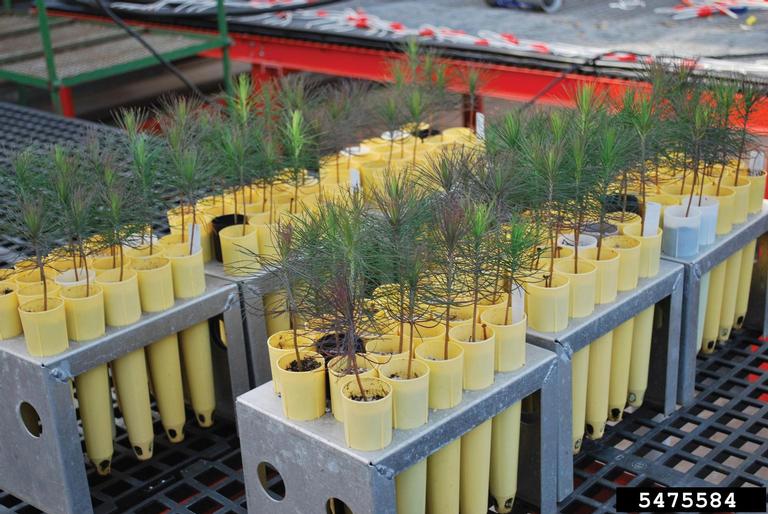Growing Native Trees from Seed - February 24, 2016 Jeff Schalau, Agent, Agriculture & Natural Resources University of Arizona Cooperative Extension, Yavapai County Native trees can be grown at home from seed, but it requires some knowledge, proper materials, facilities, time, and dedication. Materials include: sterile soil media, containers, irrigation, a cold frame or other protected space, and of course, quality seeds. Curious gardeners usually have the necessary characteristics and can easily muster up materials and growing space. Late summer and fall are good times of year to collect seed from many of our native trees for propagation. Some seeds need some “after ripening” to germinate others need cold moist treatment or physical abrasion to overcome dormancy. Think about it…without these adaptations, wild populations would germinate at the wrong time of year and be killed by frost, heat, drought, hungry predators, and/or pathogens. Mortality is to be expected. If every seed produced grew into a mature tree, we would be climbing through a dense thicket just to get from our house to the road. Almost all tree seeds require a treatment to break dormancy. Stratification is the most common. Stratification is a period of exposure to moist, cold (33 to 41 degrees F) conditions for a specified period of time (1 to 6 months). In species that require stratification, the treatment causes gradual and progressive internal physiological changes that lead to more successful germination. Simply put, stratification mimics the cold, damp winter. Commercial producers use fancy equipment, but at home you can stratify seeds by wrapping them in a well-moistened paper towel inside a mostly closed ziplock bag and placing it in a corner of your refrigerator. Other plants have hard seed coats that physically prevent germination by simply not allowing moisture to enter the seed before it has tumbled in a stream or passed through the gut of an animal to weaken the seed coat. For these species, a nick in the seed coat with a file or sandpaper will increase germination. Sometimes heat is also used, especially in fire-adapted species. These techniques are called scarification. Once germinated, many tree species can be grown in containers until transplanting. Specialized tree containers are available and allow tree seedlings to develop deeper roots. Many forest nurseries use “Ray Leach Cone-tainers” (available for purchase on the Internet). Given this small amount of background information, I will provide some guidelines for germinating some Verde Valley tree species. You may also just try a few different techniques to experiment on your own. See below for additional tree growing resources. Arizona ash (Fraxinus velutina). Stratify for 90 days and sow covering with ¼ to ¾ inch of soil. Shading germinated seedling for a week or two may be desirable. Arizona cypress (Cupressus arizonica). Cut mature, two year-old cones from tree and allow to air dry until scales separate. Seed will fall out of cone. Stratify for 21 days and sow covering with less than ¼ inch of soil. Arizona sycamore (Platanus wrightii). Stratify for 60 to 90 days and sow covering with ¼ inch of soil or mulch. Protect from birds and small mammals. Arizona sycamore requires moderate to frequent irrigation. Desert willow (Chilopsis linearis). Harvest mature seedpods just before pods open. Lay pods out to dry and collect seed when pods open. No stratification is necessary, but storage in wet sand for several days speeds germination. Sow ¼ inch deep. Netleaf hackberry (Celtis reticulata). Harvest mature fruits and remove flesh by soaking in water and rubbing against a screen (this process is called wet maceration). Stratify for 60 to 90 days and sow covering with ½ inch of firmed soil. Protect from birds and small mammals. Velvet mesquite (Prosopis velutina). Harvest mature seedpods just before pods open. Allow to dry then crush to extract seed. Many of the seeds will be likely be killed by weevils (small holes in seeds). Scarify seeds by nicking with a single edge razor or knife. Sow covering with ¼ inch soil. Western soapberry (Sapindus drummondii). Harvest mature fruits in fall and remove flesh by soaking in water and screening. Stratify seed for 90 days and sow covering with ¾ inch of firmed soil. Germination may also be enhanced by scarification. Naming of companies or products is neither meant to imply endorsement by the author nor criticism of similar companies or products not mentioned. Follow the Backyard Gardener on Twitter – use the link on the BYG website. If you have other gardening questions, call the Master Gardener help line in the Camp Verde office at 928-554-8992 or e-mail us at verdevalleymg@gmail.com and be sure to include your name, address and phone number. Find past Backyard Gardener columns or provide feedback at the Backyard Gardener web site: http://cals.arizona.edu/yavapai/anr/hort/byg/.  Additional Resources Reforestation, Nurseries, & Genetics Resources The update of the Seed of Woody Plants in the United States which was first published in 1974 by the USDA Forest Service www.rngr.net/publications/wpsm Propagating Plants from Seed Pacific Northwest Extension Publication PNW0170 cru.cahe.wsu.edu/CEPublications/pnw0170/pnw0170.pdf Stuewe & Sons One source for Ray Leach Containers www.stuewe.com/products/rayleach.php |